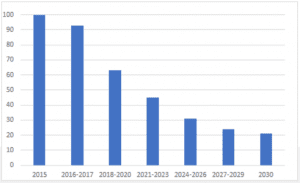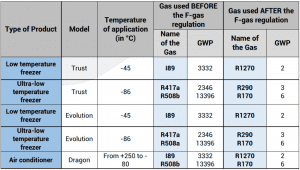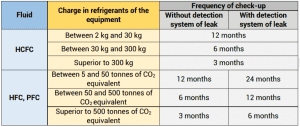F-Gas Regulations
From 1st January 2020, F-gas regulations apply to control the use of greenhouse gases in the refrigeration and air conditioning fields. The goal of this law is to reduce global warming by using refrigerants more respectful of the environment. So, the refrigeration field is directly impacted by this change.
In the actual ecological situation, reducing the effect of the cooling field on earth is important. Froilabo is committed to its values and makes it a priority to protect your samples, secure the user and reduce the ecological footprint of its product. That’s why Froilabo products are available with natural gases.
Following Montréal (1987) and Kyoto’s (1997) protocols, measures about greenhouse gases were taken. A European regulation (F-gas regulation) relating to fluorinated greenhouse gases was published in April 2014 concerning various products, especially refrigerating and air conditioning products. The goal of this new regulation is the reduction of “greenhouse gas emissions by 80% to 95% below 1990 levels by 2050 to limit global climate change” for developed countries.
From an ecological point of view, the goal is to limit climate changes and avoid side effects on climate on a worldwide scale.
Definitions
GWP (Global Warming Potential): A measure of the noxiousness of a gas as a function of its impact on global warming. This measure is calculated according to the lifespan of the gas and its radiative property. The value of reference is equal to 1 and corresponds to the CO2. More the GWP value is high, the corresponding gas has a noxious activity for earth. Tonnes of CO2 equivalent: It’s a measure of reference to calculate emissions of various greenhouse gases, on the base of their GWP. A Tonne of CO2 equivalent is the value of reference equal to 1 for the CO2.
Fluorinated greenhouse gases: Fluorinated greenhouse gas (also called F-gas) are synthetic families of gases that comprise HFC, PFC and SF6.
HFC (Hydrofluorocarbon): Organic compounds that contain fluorine, carbon, hydrogen. An example of a HFC is fluoroform, difluoromethane…
HCFC (Hydrochlorofluorocarbon): Organic gases that are fully or partially halogenated hydrocarbons that contain only carbon, hydrogen, chlorine and fluorine.
PFC (Fluorocarbon): Organofluorine compounds that contain only carbon and fluorine atoms. An example of PFC is tetrafluoromethane.
HC (Hydrocarbon): Organic compound that only contains carbons and hydrogens.
I89: Isceon 89
Leakage detection system: a calibrated mechanical, electrical or electronic device for detecting leakage of fluorinated greenhouse gases which, on detection, alerts the operator.
What is going to change?
From 1st January 2020, the F-gas regulation evolved, and new instructions started. The F-gas regulation aim to progressively stop the use of HFC with high GWP on several deadlines.
Two major directives, about our products, will come into effect in 2020 concerning:
- First, « Stationary refrigeration equipment, that contains, or whose functioning relies upon, HFCs with GWP of 2 500 or more except equipment intended for application designed to cool products to temperatures below -50°C ».
- And secondly, « Refrigerators and freezers for commercial use (hermetically sealed equipment) that contain HFCs with GWP of 2 500 or more ».
In 2022, those directives will be more precise and important as they will concern the same types of products but with restriction more important:
- « Refrigerators and freezers for commercial use (hermetically sealed equipment) that contain HFCs with GWP of 150 or more ».
- « Multipack centralised refrigeration systems for commercial use with a rated capacity of 40 kW or more that contain, or whose functioning relies upon, fluorinated greenhouse gases with GWP of 150 or more, except in the primary refrigerant circuit of cascade systems where fluorinated greenhouse gases with a GWP of less than 1 500 may be used »
Down Phase
The goal is to reduce greenhouse gases used as refrigerants in the field of cooling. Until now, refrigerants used were harmful for the Earth. Indeed, they were contributing to the degradation of the ozone layer and to global warming. That’s why they are going to be replaced by natural gases. The goal being to make gases with high GWP slowly disappear. Most common refrigerants used in the field of freezing are HFC. And most of them have a high GWP. The goal is to reduce their use in the years to come and to replace them by green refrigerants.
The objective of the “Down phase” is to eradicate fluorinated greenhouse gases through the increasing scarcity of HFC in function of their GWP. So, the quantity and importation of these products on the market will decrease and their price will noticeably increase.
A calendar of the “Down phase” about the evolution of HFC on the next 10 years is presented (graph below).

Estimated graph about percentages to calculate the maximum quantity of hydrofluorocarbons to be placed on the market and corresponding quotas as a function of years (numbers in tonnes of CO2 equivalent).
How does the change happen at Froilabo?
On which types of products this regulation applies? And how to replace these HFC and with which refrigerants? To answer your questions concerning our products, here’s a table resuming all the information.
For freezers, HC are natural refrigerants or green refrigerants that will replace HFC. The two most common green gases used in this category are propane (R290) and ethane (R170). These gases can be used because they have lower GWP than HFC.

Obligations of the equipment holder
Containment: The equipment holder containing greenhouse gases needs to be careful to avoid gases rejection. And the holder needs to look after the equipment and make sure it is fix in the best possible period in case of detection of a gas leak.
Labelling: Products need to have a label with the following information:
- A reference that the product contains fluorinated greenhouse gases
- The accepted industry designation of the gas or its chemical name
- The quantity (in weight and in CO2 equivalent) of gas contained in the product and the global warming potential
- A reference that gases are contained in hermetically sealed equipment
- If there is a leakage detection system
The label must be perfectly visible and clear.
Qualification: Persons that handle installation, servicing, maintenance, repair or decommissioning of the equipment need to have a certification.
Record keeping: Operators of equipment which is required to be checked for leaks shall establish and maintain records specifying the following information:
- The quantity and type of gas installed
- The quantity of gas added during installation, maintenance or servicing or due to leakage
- The quantities of installed gases that have been recycled or reclaimed, including the name and address of the recycling or reclamation facility and the certificate number, the identity of the company
- Dates and results of the checks carried out
And for those owning an equipment with heavy charges of gas?
It must be known that this regulation also applies to products in the fields of air conditioning and equipment of cooling with heavy quantities of gas. At Froilabo, quantities of gas used are not following severe verifications because they are under 2 kg for most of our products, except for CRP (Fast plasma freezer). Indeed, for this product, it possesses more important charges in gas so will be submitted to dedicated controls.
If you own in your laboratory or your company, an equipment with heavy charges of gas, here’s some indications. In this case, a frequency of leak checks needs to be respected and with a certain periodicity. Those data could be useful if you possess this type of equipment.
Periodicity of leak checks
For equipment that has heavy charges of refrigerants, a periodicity of leak checks must be respected.

Find out More
Are you interested by this subject? Our team is passionate and available to answer your questions, feel free to contact us and someone will be happy to help.
Alternatively, to be the first to hear about future products, news and research from Froilabo, why not take a moment to join us on social media and sign up to our eNewsletter?



